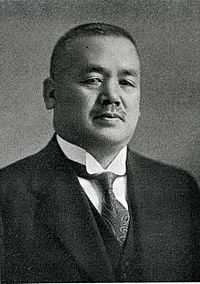Chikuhei Nakajima
| Chikuhei Nakajima 中島 知久平 | |
|---|---|
 Chikuhei Nakajima | |
| Born |
January 1, 1884 Nitta District, Gunma, Japan |
| Died | October 10, 1949 (aged 65) |
| Nationality | Japan |
| Occupation | Industrialist, Politician, Cabinet Minister |
Chikuhei Nakajima (中島 知久平 Nakajima Chikuhei , January 1, 1884 – October 10, 1949), was a Japanese naval officer, engineer, and politician, who is most notable for having founded Nakajima Aircraft Company in 1917, a major supplier of airplanes in the Empire of Japan. He also served as a cabinet minister.
Biography
Nakajima was born in Nitta District, Gunma, (currently part of Ōta city), where his father was a farmer. Nakajima attended the Imperial Japanese Naval Engineering School, graduating from the 15th class in 1903. He was commissioned as a lieutenant in the Imperial Japanese Navy in 1909. On October 27, 1911, he piloted Japan’s first airship. He was also promoted to captain at the end of 1911. After attending the Naval Staff College in 1912, he was sent for further studies to the United States, where he became the 3rd Japanese to receive a pilot’s license upon graduation from a flight school established by Glenn Curtiss. On his return to Japan, he designed an improved version of the Farman float plane for the Imperial Japanese Navy. Nakajima was dispatched as a military attaché to Europe in 1916, to observe first-hand the use of aircraft in combat. On his return to Japan in 1917, he resigned from the military, and opened a company to produce aircraft in Japan in his hometown of Ōta in Gunma Prefecture. Nakajima received financial support from fellow engineer Seibei Kawanishi, and the company was called Nihon Hikoki Seisakusho KK (Japanese Aeroplane Manufacturing Work Co. Ltd). This company became the Nakajima Aircraft Company after the partners split in 1919, and the same year, the new company received its first order for 20 aircraft from the Japanese military.
Nakajima first ran for public office during the 1930 General Election, when he was elected to the Lower House of the Diet of Japan with the support of the Rikken Seiyūkai political party. He turned control of Nakajima Aircraft over to his brother in 1931 in order to devote his efforts to politics full-time, and was subsequently re-elected four times from the Gunma No.1 Electoral District.
From June 1937 through January 1939, Nakajima served as Railway Minister under the Konoe administration. Nakajima also headed an influential political faction within the Rikken Seiyūkai. He was awarded with the Order of the Sacred Treasure, 2nd class.
Nakajima was highly critical of the decision by Japan to declare war on the United States, and warned of the dangers posed by America’s industrial strength and production capabilities and growing air power. He was outraged by the decision of the Japanese military to abandon his project for a long-range bomber capable of striking at targets in North America. Although Nakajima was forced to join the Taisei Yokusankai, he was vocally critical of the new political organization. While recognizing the advantages of a single-party system, he accused it of being unconstitutional and of attempting to create a new shogunate.
After the surrender of Japan, Prime Minister Higashikuni asked Nakajima to accept the cabinet posts of Minister of Munitions (which he held for a week until it was abolished) and Minister of Commerce and Industry (which he held for just over a month). Afterwards, he was arrested along with all other members of the former Japanese government by the Supreme Commander of the Allied Powers and was held in Sugamo Prison for trial for war crimes. Nakajima was released on parole before his trial came to court in 1947. In 1949, while at his home in Mitaka, Tokyo, he died of an Intracranial hemorrhage. His grave is at the Tama Cemetery in Fuchū, Tokyo.[1]
See also
- Nakajima Aircraft Company
- Fuji Heavy Industries (the successor to his original company)
References
- Gunston, Bill. World encyclopaedia of aircraft manufacturers: from the pioneers to the present day. Naval Institute Press (1993) ISBN 1-55750-939-5
- Mikesh Robert C. Japanese aircraft 1910-1941. Putnam Aeronautical Books, University of Michigan (1990) ISBN 0-85177-840-2
- Nicolaou, Stephane. Flying Boats and Seaplanes: A History from 1905. MBI (1998) ISBN 0-7603-0621-4
| Wikimedia Commons has media related to Chikuhei Nakajima. |
External links
| Political offices | ||
|---|---|---|
| Preceded by Takuo Godō |
Railway Minister Jun 1937 - Jan 1939 |
Succeeded by Yonezō Maeda |
| Preceded by Teijirō Toyoda |
Minister of Munitions Aug 1945 - Aug 1945 |
Succeeded by position abolished |
| Preceded by Nobusuke Kishi |
Minister of Commerce and Industry Aug 1945 - Oct 1945 |
Succeeded by Saburō Ogasawara |
|